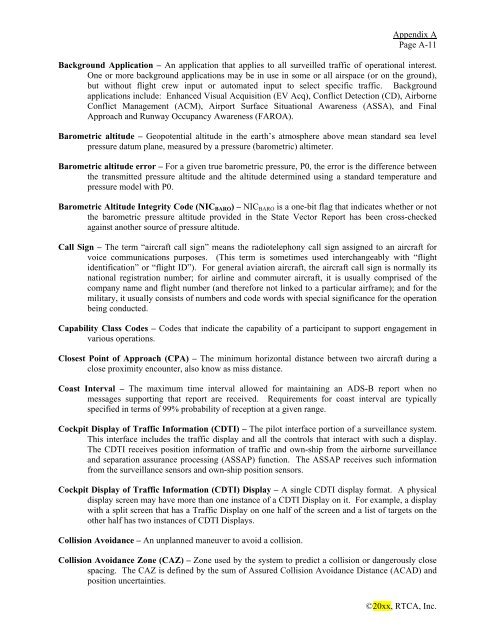Minimum Aviation System Performance Standards for Aircraft ...
Minimum Aviation System Performance Standards for Aircraft ...
Minimum Aviation System Performance Standards for Aircraft ...
You also want an ePaper? Increase the reach of your titles
YUMPU automatically turns print PDFs into web optimized ePapers that Google loves.
Appendix A<br />
Page A-11<br />
Background Application – An application that applies to all surveilled traffic of operational interest.<br />
One or more background applications may be in use in some or all airspace (or on the ground),<br />
but without flight crew input or automated input to select specific traffic. Background<br />
applications include: Enhanced Visual Acquisition (EV Acq), Conflict Detection (CD), Airborne<br />
Conflict Management (ACM), Airport Surface Situational Awareness (ASSA), and Final<br />
Approach and Runway Occupancy Awareness (FAROA).<br />
Barometric altitude – Geopotential altitude in the earth’s atmosphere above mean standard sea level<br />
pressure datum plane, measured by a pressure (barometric) altimeter.<br />
Barometric altitude error – For a given true barometric pressure, P0, the error is the difference between<br />
the transmitted pressure altitude and the altitude determined using a standard temperature and<br />
pressure model with P0.<br />
Barometric Altitude Integrity Code (NICBARO) – NICBARO is a one-bit flag that indicates whether or not<br />
the barometric pressure altitude provided in the State Vector Report has been cross-checked<br />
against another source of pressure altitude.<br />
Call Sign – The term “aircraft call sign” means the radiotelephony call sign assigned to an aircraft <strong>for</strong><br />
voice communications purposes. (This term is sometimes used interchangeably with “flight<br />
identification” or “flight ID”). For general aviation aircraft, the aircraft call sign is normally its<br />
national registration number; <strong>for</strong> airline and commuter aircraft, it is usually comprised of the<br />
company name and flight number (and there<strong>for</strong>e not linked to a particular airframe); and <strong>for</strong> the<br />
military, it usually consists of numbers and code words with special significance <strong>for</strong> the operation<br />
being conducted.<br />
Capability Class Codes – Codes that indicate the capability of a participant to support engagement in<br />
various operations.<br />
Closest Point of Approach (CPA) – The minimum horizontal distance between two aircraft during a<br />
close proximity encounter, also know as miss distance.<br />
Coast Interval – The maximum time interval allowed <strong>for</strong> maintaining an ADS-B report when no<br />
messages supporting that report are received. Requirements <strong>for</strong> coast interval are typically<br />
specified in terms of 99% probability of reception at a given range.<br />
Cockpit Display of Traffic In<strong>for</strong>mation (CDTI) – The pilot interface portion of a surveillance system.<br />
This interface includes the traffic display and all the controls that interact with such a display.<br />
The CDTI receives position in<strong>for</strong>mation of traffic and own-ship from the airborne surveillance<br />
and separation assurance processing (ASSAP) function. The ASSAP receives such in<strong>for</strong>mation<br />
from the surveillance sensors and own-ship position sensors.<br />
Cockpit Display of Traffic In<strong>for</strong>mation (CDTI) Display – A single CDTI display <strong>for</strong>mat. A physical<br />
display screen may have more than one instance of a CDTI Display on it. For example, a display<br />
with a split screen that has a Traffic Display on one half of the screen and a list of targets on the<br />
other half has two instances of CDTI Displays.<br />
Collision Avoidance – An unplanned maneuver to avoid a collision.<br />
Collision Avoidance Zone (CAZ) – Zone used by the system to predict a collision or dangerously close<br />
spacing. The CAZ is defined by the sum of Assured Collision Avoidance Distance (ACAD) and<br />
position uncertainties.<br />
©20xx, RTCA, Inc.
















